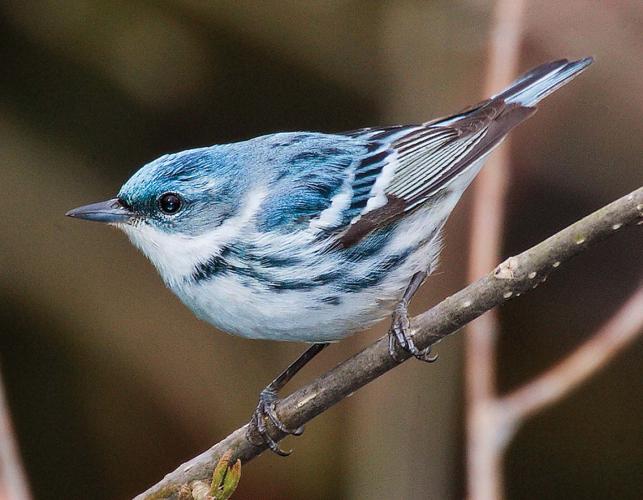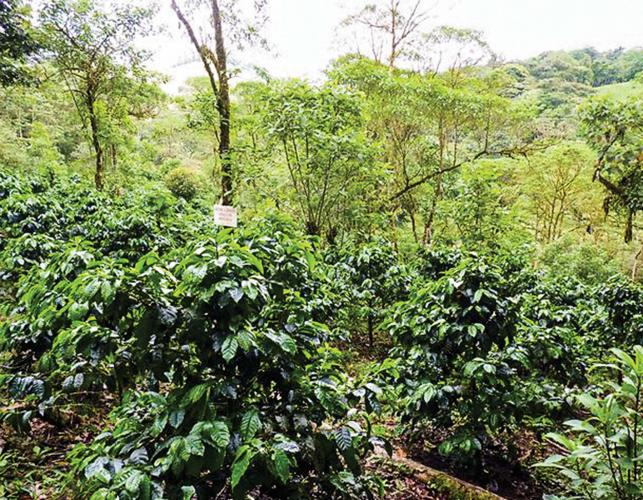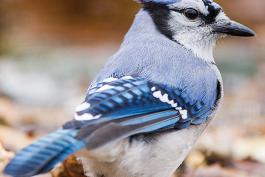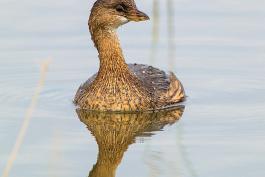Many Missourians enjoy watching birds in their backyards or at conservation areas, counting different species, and keeping life lists. Many also look forward to fall when hunting seasons for waterfowl and upland game birds open.
While we may think of birds that reside in our state as Missouri’s birds, in reality many of those birds are migratory and can spend nearly eight months of the year in different countries. Working with international partners on bird conservation efforts is therefore a win-win scenario — if birds don’t have the necessary resources on the wintering grounds, it directly impacts our enjoyment of those birds here at home.
To Migrate or Not to Migrate
All birds are generally considered residents or migrants. Resident birds spend all year in the same general location. Migrants include birds that breed in Missouri and then travel south for the non-breeding season to locations where insects, seeds, and fruits are readily available. The ranges of most resident birds and the migration patterns of some migrant birds are well known, especially those that spend all or part of the year within the United States and Canada. There are 431 species of both resident and migratory birds that have been observed and documented in Missouri.
Ornithologists, or bird scientists, categorize migrants into three basic subsets based on their migratory behavior: short-, medium-, and long- distance migrants. Short-distance migrants shift their ranges only slightly. For example, in the western United States, some birds migrate from higher to lower elevations from a mountaintop to a valley. In Missouri, birds may move from upland areas to bottomland habitats in search of food. Even some birds that are considered residents such as the pileated woodpecker, tufted titmouse, black-capped and Carolina chickadees, white-breasted nuthatch, Carolina wren, and northern cardinal may move slightly south to find food, but there are always a few individuals that stay put.
Medium-distance migrants may leave Missouri in the winter and move to a nearby state or several states to the south in search of food. Much of these birds’ ranges remain within the United States. This type of migration is usually in response to local weather events or lack of food. Likewise, birds that nest farther north spend the winter months in Missouri where it’s warmer. Examples of medium-distance migrants include double-crested cormorants, pied-billed grebe, turkey vultures, American woodcock, American kestrel, eastern phoebe, blue jay, house wren, American robin, brown thrasher, eastern towhee, and field sparrow.
Long-distance migrants usually leave Missouri, the United States, and Canada altogether and winter in Mexico, Central America, the Caribbean, or South America. The stimulus for long-distance migration is controlled primarily by changes in day length, a response to temperature, and the availability of food.
Scientists have studied long-distance migrants for many years and their work has shown that long-distance migrants have amazing capabilities to use cues from the position of the sun and stars during migratory flights in the day and night, respectively. Some are thought to use the magnetic fields of the earth and perhaps even employ “brain maps” or have genetic bases for following migratory patterns.
Ornithologists have speculated that many birds likely use a combination of these cues to navigate their migratory pathways. Examples of long-distance migrants are Mississippi kite, peregrine falcon, American golden-plover, upland sandpiper, least tern, yellow-billed cuckoo, common nighthawk, chimney swifts, eastern kingbird, red-eyed vireo, purple martins, wood thrush, ovenbird, yellow-breasted chat, scarlet tanager, dickcissel, bobolink, and orchard oriole.
Off the Beaten Path
Most species of birds can fly, and because of this ability — and to the delight of many citizens who enjoy them — can end up in many unexpected places around the world. About 90 of the 431 bird species on the Audubon Society of Missouri’s Annotated Checklist of Missouri Birds are not regular visitors to Missouri. This official checklist for Missouri, online at mobirds.org/RecordsCommittee/MOChecklist.aspx, includes the exciting, once-in-a-lifetime birds that passionate birders will drive hours for a chance to see.
Once, a garganey and a smew, two species of ducks, migrated down the wrong continent from their normal route in the Eastern Hemisphere and were seen in 2014 in Chariton County and 2001 in St. Charles County, respectively. A band-rumped storm-petrel and sooty tern, both seabirds, were carried to Missouri by a hurricane and died from the exhaustion of being carried aloft unable to land for days. A green violetear hummingbird wandered north from Mexico and showed up once at a nectar feeder in the Ozarks. A fork-tailed flycatcher overshot its winter home in the tropics of northern Brazil, Venezuela, and eastern Colombia by a long shot, and was carried by the wind to northwest Missouri. These are just a few of the many fascinating examples of rare birds appearing in Missouri as the result of strange or adverse conditions during migration.
Shortening the bird list by these fascinating vagrants and accidental species leaves approximately 335 species that annually are observed by birders in Missouri. Of these 335 species, 170 annually nest and raise their young in Missouri. About half of those migrate during the non-breeding season outside of the boundaries of Missouri, and one-third migrates to countries outside the United States.
Full Life-Cycle Bird Conservation
Full life-cycle bird conservation is the conservation of habitats and resources that birds use throughout their lives in all parts of the world, not just on the breeding or winter grounds. Because birds may live for many years or even decades, the phrase full life-cycle bird conservation is quite fitting.
The Conservation Department is a veteran supporter and promoter of full life-cycle conservation. The Department’s mission is to protect and manage the forest, fish, and wildlife resources of the state and to facilitate and provide opportunities for all citizens to use, enjoy, and learn about these resources. The stewardship of migratory species is complicated, because birds — just like bats, butterflies, and dragonflies — are not stationary year-round, and efforts must be coordinated in different parts of the world.
The annual life cycle of a bird may include bottlenecks or pinch-points of high-quality habitat and limiting factors anywhere on breeding and non-breeding grounds and along their migratory journeys. The Department works to alleviate these challenges in Missouri by protecting public land and managing habitats within that land to benefit many kinds of birds.
But challenges in other parts of the world have the potential to limit the success of bird populations either during migration or surviving throughout the winter months. Thus, these areas also must be managed, conserved, and protected. In short, conservation efforts in Missouri need to be coupled with efforts in other parts of the world to be truly effective.
Because half of Missouri’s breeding species leave during the non-breeding season, the Department works with many trusted and critically valuable partners outside of Missouri. Partner efforts ensure the protection and enhancement of high-quality migratory stopover habitat, breeding sites farther north for birds that winter in Missouri, and wintering sites in the tropics for birds that breed in Missouri and migrate south.
Southern Wings
State fish and wildlife agencies have been building a strong, highly-functional partnership that links states with national-level bird organizations like the National Audubon Society, American Bird Conservancy, and others promoting international bird conservation. These agencies spend considerable time, money, and effort to ensure that good bird habitat exists within their states.
Southern Wings is a partnership that supports a common vision of providing funding for bird conservation projects in Mexico, Central America, South America, and the Caribbean for state-selected priority birds throughout their annual life cycle. Currently, Missouri is one of 29 states that participate in the Southern Wings Program. The program provides the coordination necessary to enhance the quality and success of on-the-ground habitat and breeding bird population conservation efforts that all states have worked to protect.
The Conservation Department has been a partner in Southern Wings since 2009. On-the-ground conservation activities are numerous and include land protection in Quintana Roo, Yucatan Peninsula, Mexico. In El Cielo Biosphere Reserve, Tamaulipas, Mexico, migrant bird monitoring and mist netting were used to determine what migratory flyways and habitats are used by Missouri’s breeding birds. Conservation efforts of the Southern Wings partnership also include working with local landowners around the Reserva El Jaguar, Nicaragua, for migrant-bird-friendly coffee production landscapes, protecting 47,000 acres of tropical forests on the Caribbean slopes in Guatemala, and cerulean warbler land conservation linkages, public awareness, and education in Colombia, South America.
Recent work in Guatemala illustrates these far-reaching efforts. In May, the Guatemalan National Congress passed a law that declared 46,950 acres of a mountainous region on the Caribbean slope as a new national protected area. State fish and wildlife agencies of Ten nessee, Arkansas, Iowa, and Texas have been in partnership with the Conservation Department to secure this land since 2012 for the migrant birds that winter or stop there during migration to refuel in this region. The newly protected parcel is a World Alliance for Zero Extinction Site and also will protect many endemic and endangered amphibians found on the area. It is Guatemala’s first new nationally protected area in seven years.
An Advocate for Birds
Brad Jacobs, the Conservation Department’s ornithologist, is dedicated to these programs’ advocacy, expertise, and coordination in the interest of bird conservation. With 56 years of birding experience and 25 years with the Department, he has advocated for bird conservation partnerships at the local, state, national, and international levels.
Jacobs began his Department bird conservation efforts working with nearly 400 of Missouri’s birders on the Missouri Breeding Bird Atlas Project. He co-authored a publication in 1997 of the same name with then-state ornithologist James Wilson. Jacobs authored another Department publication, Birds in Missouri, in 2001.
Jacobs has worked with 14 Audubon Society chapters in the state to establish the Audubon Missouri office of the National Audubon Society. He worked to establish and lead an organizational effort to set up guidelines for the Missouri Bird Conservation Initiative, and the Southern Wings Program effort was born with a presentation by Jacobs on full life-cycle bird conservation to the Bird Conservation Committee of the Association of Fish and Wildlife Agencies in 2005.
More to Come
Birds are familiar, likeable, and enjoyed by many. Even those who do not birdwatch enjoy the ecological benefits provided by these animals. The Department, its myriad of conservation partners, and Missouri’s birding community work hard to be stewards of the land and resources that provide homes for birds, if only for part of the year.
Studying, surveying, and monitoring birds teach us a lot about essential bird habitat requirements and provide guidance for habitat management efforts not only in Missouri, but in other parts of the world. Look to future Conservationist articles to learn more about ways that you can get involved with birdwatching, how to become a volunteer for bird monitoring efforts, and how to improve your backyard for birds and other wildlife. Citizen participation makes nationwide bird monitoring possible, and therefore essential in the effort to conserve natural resources for future generations.
Long-Distance Migrants
In all, about 1,800 of the 10,000 bird species worldwide are long-distance migrants. Long-distance migrants annually migrate from a breeding ground to a non-breeding ground over long distances, often over thousands of miles. Scientists use small, lightweight GPS units, called geolocators, attached to birds to download locational data and track migration routes. Bar-tailed godwits are large shorebirds and strong fliers. One individual was tracked with a geolocator over its nonstop flight from western Alaska to New Zealand — a distance of 7,200 miles one way in nine days! Peregrine falcons log about 25,000 miles on their round-trip migration from the Arctic to the Antarctic region and back. Many small songbirds travel thousands of miles. For example, cerulean warblers migrate 3,300 miles one way from breeding grounds to their winter ranges.






















And More...
This Issue's Staff
Managing Editor - vacant
Art Director - Cliff White
Staff Writer/Editor - Brett Dufur
Staff Writer - Jim Low
Photographer - Noppadol Paothong
Photographer - David Stonner
Designer - Stephanie Thurber
Circulation - Laura Scheuler






















